
Newsletter - February 2015
Greetings from Robbi and Jim
A warm welcome to all of the members of our Aroma Tours Newsletter from around the world.
Robbi
and I are excited to be at the beginning of another delightful year of
adventures and we feel blessed to be living our passion and to see our dream
of sharing the wonderful places, people and experiences that we love
continuing to unfold each year.
Once again we will be welcoming back a significant number of returning Aroma
Travellers and their friends who currently make up almost 60% of our guests; which is quite
remarkable and something that we are are very grateful for and proud of.
This year is all set to be our most successful tour season ever and Robbi
and I hope that you will be able to join us.
For detailed information about our tours please visit our information request page and if you would like to join us please visit our booking request page to reserve your place.
Aroma Travellers Our Thanks
Without doubt, the main reason that we continue to grow and flourish, is the on-going support we receive from our past Aroma Travellers.
Last year we enjoyed an outstanding number of returning Aroma Travellers and new guests who joined us because of direct referrals - over 63% of our guests! A similar result is occurring this year as well.
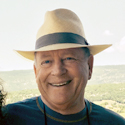
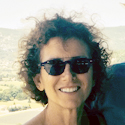





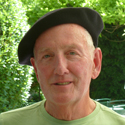

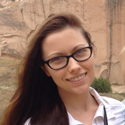





 |
For Robbi and myself, it is such a great delight to welcome back so many good friends and to see our Aroma Tours continuing to flourish.
We would also like to give our heart-felt thanks to all of you who continue to support us with your kind words and referrals as you spread news of our tours and retreats amongst your friends.
Robbi and I also greatly appreciate your wonderful words of thanks, it means so much to us to know that we have shared a special time with you during our journey together.
If you have not already done so, please take a peek at our Guest Comments from 2014
Flavours of Spain ( bookings closing soon )
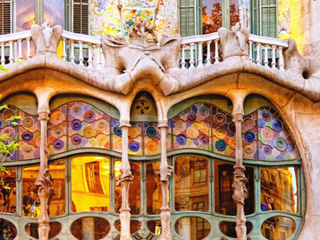 This
year's adventures begin with one of our most delightful gastronomic
offerings, our wonderful
Flavours of Spain Tour; a pilgrimage that explores the world renowned fine cuisine,
exceptional wines, rich culture and sweeping beauty of North Eastern Spain.
This
year's adventures begin with one of our most delightful gastronomic
offerings, our wonderful
Flavours of Spain Tour; a pilgrimage that explores the world renowned fine cuisine,
exceptional wines, rich culture and sweeping beauty of North Eastern Spain.
We will journey from the
magnificent city of Barcelona, renowned for its elegance, vibrancy and
incredible architecture to Rioja Alavesa, one of the world's premier wine regions,
along the legendary pilgrim's path of the Camino de Santiago, to the magnificent
coastline of the Bay of Biscay home to the highest concentration of Michelin starred fine restaurants
in the world.
You will experience
amazing Barcelona, enchanting villages, glorious seaside vistas,
rich culture, stunning
architecture, lush vineyards, colourful markets, ancient abbeys, lovely art, beautiful
countryside and fascinating historical visits.
We have compiled a page of
photos of
our Flavours of Spain tour for your viewing pleasure and to give
you a sense of the wonderful places, experiences, fabulous food and wines
that we will enjoying with our guests.
There are also more lovely photos of Spain on our Memorable Photos of 2013 #1 page
Flavours of Spain is now one of our most popular tours and Robbi and I hope that you will be able to join us next May.
For more details please visit our information request page and if you would like to share this wonderful adventure with us you can reserve your place via our booking request page
The Story of Champagne
 The story of champagne begins with the Romans who planted the first vines in
52 BC and created extensive underground limestone quarries for their
constructions which later became the famous network of "crayeres"
used for storing and ageing the wines of Champagne.
The story of champagne begins with the Romans who planted the first vines in
52 BC and created extensive underground limestone quarries for their
constructions which later became the famous network of "crayeres"
used for storing and ageing the wines of Champagne.
"La Champagne" - the place, is feminine in the French language and
has a very dark history full of war and suffering, yet "le champagne"
- the wine, is associated with celebration, romance and good times.
Nothing about le champagne is simple or straight forward; it is born of contradictions. It takes poor soil to make good champagne, black grapes to make a white wine, and the man credited with creating the first champagne - "a blind man who saw stars", wasn't blind, made only red wines and spent most of his life working to keep the bubbles out of his wines.
The wines of La Champagne became associated with royalty in the fifth century AD with the Frankish king Clovis, who after having defeated the Romans, and establishing his kingdom around Reims, found himself facing almost certain defeat from invading Germanic tribes.
Clovis's fiance, a Christian, urged him to pray to her God for deliverance. Clovis who was a pagan, agreed and vowed that if God granted him victory, he would become a Christian. True to his word, after miraculously winning the un-winnable battle, on Christmas day 496, he and three thousand of his soldiers went to the church in Reims to be baptized. During the huge banquet that followed, the wine of Champagne was served. Not the champagne we know, but a cloudy, red wine with not a bubble in sight.
As a result of these events, the wines of La Champagne become famous as a celebratory drink and from then on, every king of France insisted on being crowned in Reims and celebrating afterwards with the wine of La Champagne.
It wasn't until 1686, during the rein of The Sun King [ Louis XIV ], when the son of a minor court official in eastern Champagne, Dom Pierre Perignon, by then a monk of the Benedictine order, arrived at the rundown abbey of Hautvillers, that the next chapter in the story begins:
After many years of neglect, the abbey of Hautvillers and its vineyards were in a sorry state and Dom Perignon quickly realized that the only prospect of restoring the abbey, lay in resurrecting its once famous vineyard, whose wines had graced the table of King Phillipe-Auguste and been served at the coronations of Charles IV and Phillipe VI.
So he began the back-breaking work of clearing rocks, removing weeds, importing soil and replacing poor quality vines, to: "Eliminate those that make nothing but common wine" and introduced new techniques that became know as the "Golden Rules of Winemaking" and are still in use today:
- Use only the best grapes and discard those that are broken
- Prune vines hard in early spring to avoid overproduction
- Harvest in the cool of the morning
- Press the grapes gently and keep the juices from each pressing separate.
He was also the first in Champagne to use corks for sealing bottles, rather than wooden pegs wrapped in oil soaked hemp.
By virtue of his wisdom, gifts of observation, genius for blending and assiduous hard work, Dom Perignon succeed in making [ red ] wines with more concentration, clarity, delicacy and finesse, than anyone else's. He was also sure of what he had achieved. "Monsieur, I have given you twenty-six bottles of the best wine in the world."
Dom Perignon didn't invent sparkling champagne [ no one did ], rather, he spent his whole career trying unsuccessfully to eliminate bubbles from his wines.
The bubbles were in fact caused by the early onset of cold weather in La Champagne which meant that the fermentation process was prematurely halted before the yeasts [ which went into hibernation ] had finished their work. Once the weather warmed up again in March, the yeasts would be resurrected and re-kindle the fermentation process. This capricious behaviour of nature was considered a flaw in the wine [ no one at the time knew about the role of yeasts ].
Louis XIV [ The Sun King ] like the other Kings of France before him, was crowned in Reims and celebrated with the wines of La Champagne. Over the next fifty years he rarely drank anything else, and as a result of his patronage and the desire of other nobles in France and abroad to imitate him, the winemakers of Champagne [ and Louis ] became very prosperous indeed.
By the 1730's, Louis XV along with the rich and noble of Europe were rushing to experience the new fashion of drinking sparkling white wines from La Champagne. Louis even commissioned a painting "Le Dejeuner d'Huitres" [ The Oyster Lunch ] showing for the first time the cheery explosion of a cork from a bottle of le champagne. For Louis this new wine was the perfect symbol of the good life - gaiety, lively conversation, and elegance.
In the beginning of this era, sparkling champagne only accounted for a tiny proportion of the wines coming from La Champagne, largely because of it's capricious nature; sometimes it was flat and lacked effervescence, and at other times was "green and hard as a dog". Also it was dangerous, and due to its unpredictable habit of exploding in bottle, it was dubbed "The Devil's Wine".
Workers in the cellars of Champagne were obliged to don metal masks and heavy clothing to try and protect themselves from these explosive bottles. In some cases 90% of the bottles were lost, leaving the cellars resembling "foamy swamps". Given the risks, many Champenois were amazed when a young winegrower by the name of Claude Moet announced that he was turning over his entire production to the creation of this Devil's sparkling white wine.
Moet was a consummate salesman and believed that a new era was at hand. He very cleverly introducing his new sparkling champagne to Louis' mistress Madame de Pompadour, who remarked that "champagne is the only wine that leaves a woman beautiful after drinking it".
The celebrity of the new wine was further enhanced by the philosopher Voltaire [ a favourite of Madame de Pompadour's ] who wrote: "De ce vin frais l'ecume petillante, De nos Francais est l'image brilliante - The character of the French is mirrored in the sparkle of champagne.
Voltaire referred to the new sparking white wine simply as "champagne", rather than "vin de Champagne" as most people knew it at the time. It was a distinction that Madame de Pompadour was very adamant about and promoted strongly, and continues to this day.
The full history of champagne is full of twists and turns, struggle and triumphs but in the end perhaps Lily Bollinger sums up the place this iconic wine has found in our way of life:-
- "I drink champagne when I am happy and when I am sad. Sometimes I
drink it when alone. In company I consider it compulsory. I sip a little if I am
hungry. Otherwise I don't touch it - unless I'm thirsty of course."
~ Lily Bollinger
Our Current Booking Status
Robbi and I are thrilled to see that we remain on track for another fabulous season of tours with most of our offerings now down to the last few places.
We look forward to sharing many wonderful places, people and experiences with our guests this year and hope that you will be able to join our merry throng as well.
Our booking status at the time of this newsletter is:-
| 2015 Tour Season | |
|---|---|
|
|
|
|
|
|
|
|
|
|
|
|
For detailed information about any of our tours please visit our information request page and if you would like to join us please visit our booking request page to reserve your place.
It is our pleasure to assist you with any questions you may have and we invite you to get in touch with us either by email at [email protected] or by phone on: +613 5331 3254 (afternoon/evening USA time zones, mornings from other countries).
Please note
- Our up-to-the-minute booking status is available via our calendar page
- If the tour you would like to attend becomes fully booked, please let us know if you would like us to add you to that tour's waiting list in case a place becomes available due to a cancellation or transfer.
- We will be gradually changing our schedule of tours over the coming years to allow us more time for other projects and activities.
Photo Sliders and Tour Pages Makeover
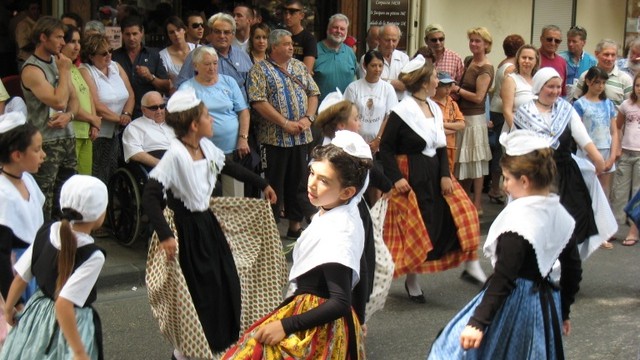
Jim has been busy updating the tour pages on our site with some lovely new images and to each he has also added a photo slider featuring 30 or so photos from each tour to give you a beautiful pictorial impression of our Aroma Tours Adventures.
Please feel free to take a peek and we hope that you enjoy the effect.
We also invite you visit our other Photo Galleries Pages to enjoy more of the 100's of other lovely photos of our aromatic adventures.
Vincent and Paul in the Studio of the South ( Atelier du Midi )
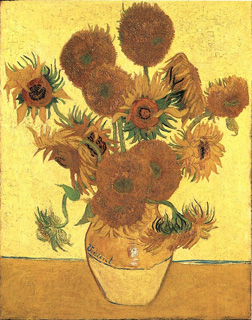 Vincent Van Gogh and Paul Gauguin were first introduced to one another in Paris by Vincent's brother Theo, who was both Vincent's
patron and Gauguin's art agent in Paris.
Vincent Van Gogh and Paul Gauguin were first introduced to one another in Paris by Vincent's brother Theo, who was both Vincent's
patron and Gauguin's art agent in Paris.
Gauguin, already a successful painter in his own right, was enthralled when he was introduced to Vincent's
vibrant painting of two sunflowers in a vase which revealed to him the artistic genius lurking within Vincent's complex and often gruff character.
Both artists increasingly found the Parisian art scene overwhelming and full of egos and criticism, although they both benefited from the influences of the Impressionists, Pointillists, neo-Impressionists
and newly popular Japanese artworks during that time.
As a result of these tensions, Vincent decided to relocate to the south in February 1888, away from the darkness of Paris and into the luminous light of Provence.
It was Vincent's dream to create an artist's community - a "Studio of the South" - to attract other innovative artists in order to share skills and inspiration and influence each another's artistic growth. For this artist's utopia he enigmatically chose a small yellow house in the seedy district of the unremarkable and rather conservative town of Arles on the Rhone river.
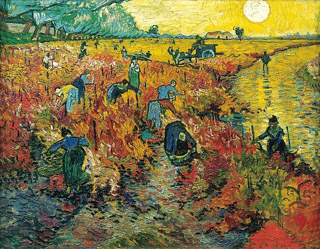 On his arrival, Van Gogh was immediately inspired by the beauty of the Provencale countryside and started painting at break-neck speed, experimenting with strong, contrasting colours ( yellow was his favourite ) and creating his own vibrant images of reality.
On his arrival, Van Gogh was immediately inspired by the beauty of the Provencale countryside and started painting at break-neck speed, experimenting with strong, contrasting colours ( yellow was his favourite ) and creating his own vibrant images of reality.
With Theo's prompting, Gauguin agreed to join Vincent in Arles that October and initially it seemed that Vincent's dream of an artist's commune was coming to fruition.
In the beginning they worked closely together, painting the scenes and people around them, sharing portrait sessions and communing at length. As a result their styles began moving closer together: Gauguin encouraged Vincent to paint more from memory rather than his usual spontaneous "in-the-moment" fashion and Vincent helped Gauguin to explore new colour possibilities and apply his paint with more intensity.
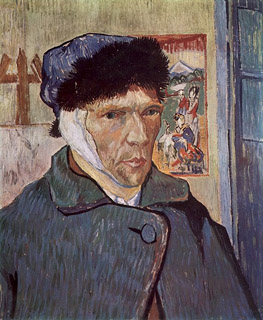 As the weeks passed, Vincent's erratic nature and personal intensity, as well as Gauguin's egoism and reluctance to praise Vincent's work, coupled with their fundamentally different philosophies and constant close proximity, led inevitably to friction and
quarrels.
As the weeks passed, Vincent's erratic nature and personal intensity, as well as Gauguin's egoism and reluctance to praise Vincent's work, coupled with their fundamentally different philosophies and constant close proximity, led inevitably to friction and
quarrels.
Gauguin's paintings began to sell and gain celebrity in Paris ( unlike Vincent who considered his work too primitive and undeveloped to exhibit ) and he began to question the wisdom of remaining so far from the action, with a man whose mental
unraveling was becoming more pronounced by the day.
Vincent responded to Gauguin's increasing fretfulness by working with fierce intensity, producing 25 pictures during what was to be a very eventful December. He was often drunk and exhausted and constantly fearful that Gauguin was going to abandon him.
On 23 December 1888, frustrated and ill, Van Gogh confronted Gauguin with a cutthroat razor, then afterwards, full of remorse and in panic, he fled to a local brothel where he cut off part of his ear.
Gauguin left Arles on Christmas Day and the two painters never saw each other again.
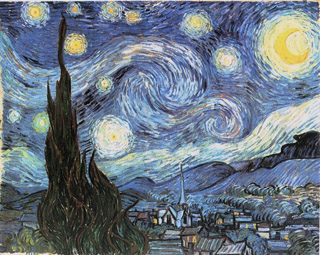 Vincent continued to deteriorate and spent his time in and out of hospital, eventually being driven out of Arles by the townsfolk and not long afterwards he admitted himself to the mental asylum of St Paul de Mausole where he continued to paint prolifically and produced some of his greatest works.
Vincent continued to deteriorate and spent his time in and out of hospital, eventually being driven out of Arles by the townsfolk and not long afterwards he admitted himself to the mental asylum of St Paul de Mausole where he continued to paint prolifically and produced some of his greatest works.
To walk in Vincent's footsteps and stand in the actual places where he created some of the world's most famous artworks is a very moving experience. One can almost imagine the easel and peasant's chair with Vincent's gaunt form shaded by his painter's straw hat intently capturing the "true reality" around him.
We explore Vincent's amazing legacy and walk in his footsteps as part of our Heart of Provence and Aromas of Provence tours.
Arranging Your Travel
Once you have reserved your place via our tour booking page, all your need to do is make your travel arrangements to meet us at the tour rendezvous point. You can either ask your travel agent to assist you, or for the more adventurous you can book your flights and connections yourselves. All of our rendezvous are easily achieved and naturally we provide all of the information and assistance that you will need.
Just a reminder that we have a frequently asked questions page to help answer the most common questions including how to book, travel arrangements, group sizes etc.
Previous Newsletters and Stories of Interest
Our past newsletters contain a lot of interesting stories and are well worth a read. You can find them by visiting our newsletter archives
You may also enjoy reading a few of the stories that we have compiled over the years on our stories of interest page
Our Invitation
Robbi and I look forward to welcoming you to one of our delightful tours or retreats in the near future and invite you to take a peek at the latest photos of our travels in our photo galleries
For detailed information about any of our tours please visit our information request page and if you would like to join us please visit our booking request page to reserve your place.
As always if you have any questions or if you would like us to assist you personally with advice about your travel arrangements or with any other details please contact us either by email at [email protected] or by phone on +61 3 5331 3254 ( afternoon/evening USA time zones, mornings from other countries ).
Please note you need to replace the '+' in our phone number with your country's international dialing prefix: from the USA/Canada it is 011 from most other countries it is 00.
Warmest regards,
Jim and Robbi